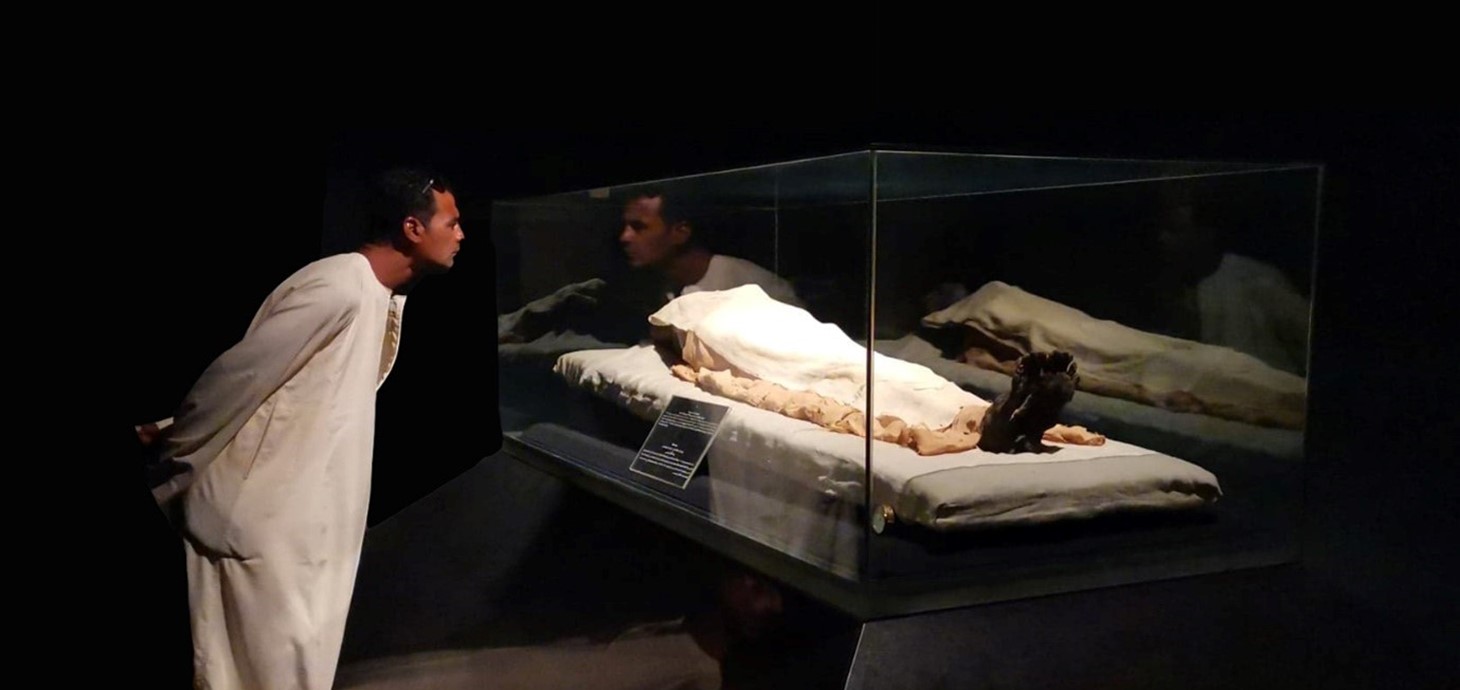
Overall winner: “Reflecting on the Past: The Display of Egyptian Mummies” (Ken Griffin/Mohamed Shabib). The image shows Mohamed – a Luxor resident - gazing into the face of the mummy of the pharaoh Ramesses I (c. 1292–1290 BC) at Luxor Museum for the first time.
Seventeen stunning images, and the fascinating stories behind them – the surprise finding inside a crocodile shark, Antarctic glaciers on the move, and the unexpected uses of insect poo - have today been revealed as the winners of the 2021 Research as Art competition.
Most of the 50 entries submitted came from Swansea University researchers, but this year’s competition also saw winning entries from other institutions.
**See the winning entries**
The overall winner is “Reflecting on the Past: The Display of Egyptian Mummies”. It was submitted by Ken Griffin of the Egypt Centre at Swansea University, and Mohamed Shabib, Conservator for the Egyptian Ministry of Antiquities.
The image shows Mohamed – a Luxor resident - gazing into the face of the mummy of the pharaoh Ramesses I (c. 1292–1290 BC) at Luxor Museum for the first time.
Overall winners Ken Griffin and Mohamed Shabib outlined the thinking behind their entry:
“The display of human remains has become an ever-increasing concern amongst museums and museum professionals for the past few decades.
Some take the view that human remains should be freely displayed, arguing that they can serve as a connection between the past and the present. On the other hand, some think that it is inappropriate to do so, regardless of the exhibit’s scientific value. Who should decide on whether human remains are displayed in museums?
Reflecting on the past examines these questions. In discussing Egyptian mummies, it is important to take into account the views of the modern Egyptians, the direct ancestors of the pharaohs.”
Research as Art is open to researchers from all subjects, with an emphasis on revealing hidden research stories, as well as composing a striking image.
It offers an outlet for researchers’ creativity, revealing the hidden stories and attempts to humanise science and research. The project also celebrates the diversity, beauty, and impact of research at Swansea University – a top 30 research university.
A distinguished judging panel of senior figures from the EuroScience, Royal Institution, Nature, Research Fortnight magazine and Digital Science selected a total of seventeen winners. Along with the overall winner, there were 5 other awards and 11 runners-up.
Judge Gail Cardew, Vice President, EuroScience, said:
“Reflecting on the past year, with the devastating effects of Covid on families and communities, this image reminds us that how we portray death is complex and constantly changing - from being a private affair, from being statistics on a graph and from being an exhibit in a museum.
This image gives us an opportunity to think about the sensitivities around the public presentation of death”.
Judging panel:
- Professor Helen Griffiths, Pro Vice Chancellor for Research, Swansea University
- Gail Cardew, Vice President, EuroScience
- Dan Cressey, Deputy Editor, Research Fortnight and Research Europe
- Martin Davies, Public Programme Manager, the Royal Institution
- Flora Graham – Senior Editor, Nature Briefing
- Dr Suze Kundu, Head of Public Engagement, Digital Science
Professor Helen Griffiths, pro vice chancellor for research at Swansea University, said:
“This year's entries have embraced many issues whilst providing a narrative which captures living and researching within a global pandemic. Topics covered include how plagues in the past threatened theatres with closures, the importance of social connectivity, and the historic and present-day public presentation of death. We also see researchers producing thought-provoking entries around globally concerning issues such as online grooming, the protection of our coastal habitats and how huge Antarctic glaciers are on the move.
I have been really impressed by the entries. The competition allows our researchers to showcase their work in a totally different way and shines a light on the diversity of research taking place here at Swansea University and at other institutions.”
Competition founder and director Professor Richard Johnston, professor in materials science and engineering at Swansea University, said:
“Research as Art is an opportunity for researchers to reveal hidden aspects of their research to audiences they wouldn’t normally engage with. This may uncover their personal story, their humanity, their inspiration, and emotion.
It can also be a way of presenting their research process, and what it means to be a researcher; fostering dialogue, and dissolving barriers between universities and the wider world.”
